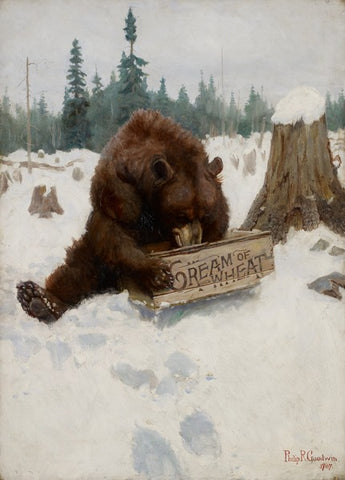
3-39 The Courtship
Cover Image for Success Magazine – December 1905
Leyendecker, J. C. (1874–1951)
1905
Courtesy of The Illustrated Gallery, Fort Washington, Pennsylvania
Joseph Christian (Joe) Leyendecker created this stylist picture in 1905. (Page 705 of Volume VIII. See: https://books.google.com/books/reader?id=V3ZNAAAAYAAJ&printsec=frontcover&output=reader&source=gbs_atb_hover&pg=GBS.PA797.] Entitled The Courtship, it appeared on the cover of the December issue of Success Magazine. Since it is not associated with an article in the magazine, I suppose Leyendecker created it to be a cover. It provides an excellent example of what Jordan Berman of The Illustrated Gallery meant when he observed that “artists produced their best work for magazine covers.”
Success Magazine’s Editor said this of its art and of Leyendecker:
Ten years ago it was not considered necessary to illustrate a magazine beyond a few pictures that might illumine the text. To-day it is an equal factor with clever literature in the "make up" of any publication worthy of a standard rank. Good artists are more difficult to secure and demand more remuneration than ever before. Mechanical devices for the reproduction of high-grade work in half-tone and color have almost reached the acme of the inventor's art. We are taking advantage of all these conditions and have im proved our art department to meet the demand of the time. Our cover designs, which have been so noted in the past, will be even more striking in the future. Success Magazine probably pays the highest price of any magazine in America for its cover designs. J. C. Leyendecker, the best cover designer in America, is one of our staff of artists. A fine sample of his exquisite workman ship is shown in our Christmas issue. [This comment, along with an image of the artist can be found on the front pages of the magazine’s December 1905 issue.]
Joe Leyendecker had begun his career over a decade before he painted The Courtship. In 1894, at the age of twenty-four, he illustrated his first book, which was an American edition of Anthony Hope’s The Dolly Dialogues. The book was published by Chicago-based E.A. Weeks & Company. He had created the first of 321 covers he produced for The Saturday Evening Post in May of 1899. He continued to provide covers for the the Post until 1943.
Joe rose to become “the best cover designer in America” by polishing his natural gifts as a draftsman and by studying in Paris with some of France’s most celebrated classically trained teachers. While working for an engraving firm in Chicago, he took lessons in figure drawing under John H. Vanderpoel at the Chicago Institute of Art. In the fall of 1896, he and his brother, Francis Xavier (Frank), traveled to Paris where they spent two years studying with Jules Joseph Lefebvre and William-Adolphe Bouguereau at the Académie Julian. They supplemented this instruction by attending classes at the Académie Colarossi on Paris’s avant garde Left Bank.
Joe may have earned his reputation creating cover art for publications like The Saturday Evening Post and Success Magazine, but he probably financed his lavish life style with the commissions he earned from clothing manufactures like Cleutt Peabody & Company, the House of Keppenheimer, Hart Schaffner & Marx, and Interwoven Socks.

The male characters Joe Leyendecker presented in his ads were poised, commanding, and charming, which made them paradigms of the era’s “smart set.” They soon became social icons the way Charles Dana Gibson’s “girls” had done a decade before. It seems everyone born during the Gilded Age wanted to become a millionaire. Joe showed them how to dress one.
I add additional details about J. C. Leyendecker’s life, career, and art in my forthcoming book Painting America’s Portrait - How Illustrators Created Their Art, which will be published this fall by Commonwealth Books of Virginia. You can learn more about at www.commonwealthbooks.org.
Jim Thompson
Illustration Art Enthusiast
jct@commonwealthbooks.org

With Trumpet and Drum
Parrish, Maxfield (1870-1967)
1904
From Poems of Childhood by Eugene Field. New York. Charles Scribner’s Sons. 1904. 2.
Online Source: http://babel.hathitrust.org/cgi/pt?id=nc01.ark:/13960/t7dr3x029;view=1up;seq=23.
This charming picture was created by Maxfield Parrish (1870–1966) in 1904. It is one of the cover images for my forthcoming book, Painting America’s Portrait – How Illustrators Created Their Art. Later in his seven-decade long career, Parrish referred to himself as “a businessman with a brush.” When he produced this piece, however, he still just an illustrator.
With Trumpet and Drum was the first of eight illustrations Oarrish created for Charles Scribner’s Sons 1904 edition of Poems of Childhood by Eugene Field (1850–1895). Field was a journalist who eventually settled in Chicago. He is remembered today for the charming poems he wrote for children. A few them, like "The Gingham Dog and the Calico Cat", and "the Dickey bird is singing in the Amphalula tree," have become classics.
Maxfield Parrish was the perfect artist to illustrate Field’s enchanting little poems. He had burst onto the national scene a few years before after creating a three-panel mural for the Mask and Wig Club at the University of Pennsylvania. The theme he chose for his sensational mural was “Old King Cole and his fiddlers three.” Fairy tale characters in faraway places, like the ones he pictured in this mural, became the thematic cornerstones for the rest of his career. I expect it is fair to say that all the pictures he created for Field’s little book are now famous and still popular.
The age of color illustration was in the process of being born when this colorized lithograph was produced. The artist and the publisher both deserve credit for being pioneers in this new technological age.
Field’s poem, which was called With Trumpet and Drum, did not have anything particular connection to the 4th of July or celebrating America, but Parrish’s work provides a wonderful expression of the sentiments that surround this colorful holiday. I talking about Maxfield Parrish and his career in my biographical sketch of him at the back of my book. It will be published this fall by Commonwealth Books of Virginia. You can learn more about at www.commonwealthbooks.org.
Jim Thompson
Illustration Art Enthusiast
jct@commonwealthbooks.org

1-1 Wild Bill Hickok at Cards – I’m Calling the Hand That’s in Your Hat
Wyeth, N. C. (1882–1945)
1916
For The Great West that Was by William Cody. Heart’s Magazine. Vol. 30. No. 4. 1916. 245.
Online Sources: http://www.gutenberg.org/files/12740/12740-h/12740-h.htm#04.
In An Autobiography of Buffalo Bill (Colonel F. Cody. New York. Farrar and Rinehart. 1920. 56. http://babel.hathitrust.org/cgi/pt?id=uc1.32106000652039;view=1up;seq=71

1-2 A Bear Chance
Goodwin, Philip R. (1882–1935)
1907
Minneapolis Institute of Arts; Gift of the National Biscuit Company.
Online Source: https://www.1000museums.com/art_works/philip-r-goodwin-a-bear-chance
This week’s “image of the week” is a two-image set. Both pictures were painted by former students of Howard Pyle, the so-called “Father of American Illustration.” Philip R. Goodwin (1882–1935) and N. C. Wyeth (1882–1945) were classmates in the Howard Pyle Scool of Illustration in Wilmington, Delaware. They both arrived in Wilmington in 1902 and “graduated” in 1904. Goodwin then returned to New York City where he opened a studio, possibility around 10th and Broadway, which was near several major publishing houses. Wyeth remained in Wilmington until 1908 when he moved his growing family and studio to Chadds Ford, Pennsylvania.
Goodwin’s ad, which he created for the Cream of Wheat Co. in 1907 appeared first. While studying with Pyle in 1902, Goodwin had received a commission from the Macmillan Company of New York to illustrate Jack London’s Call of the Wild. The book and the illustrations were both successes. I suppose this is how Cream of Wheat discovered Goodwin. He went to a very success career creating image of outdoor and hunting scenes. I put him in this post because he was what I call an “artist adman.” He applied the techniques he learned from Howard Pyle to create an appealing ad. When viewers saw it, they got the message.
Wyeth also created ads for Cream of Wheat. I put him in this post, however, because he was the quintessential storyteller. Pyle encouraged his students to insert themselves in the stories they illustrated. They could create more engrossing scenes, he said, if they became personally involved in them. None of Pyle’s student, nor anyone else, was better at involving himself in his stories than Wyeth. His itchy finger is on that trigger. He’s staring anxiously down that long dangerous barrel. He had the capacity to bring his audiences into his pictures—we’re right there with him. It this case, like so many others, we’re waiting on the edge of our seats to find out what happens. His career was even more spectacular than Goodwin’s.
These are just two artists and two pictures from the Golden Age of Illustration. I’ll be talking about many more in the weeks ahead. Bear in mind as you look at the pictures that art had come from one place and was on its way somewhere else.
Jim Thompson
Illustration Art Enthusiast
jct@commonwealthbooks.org









